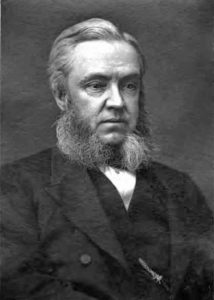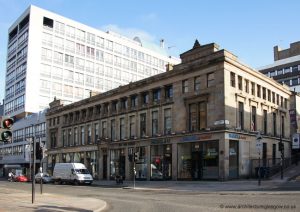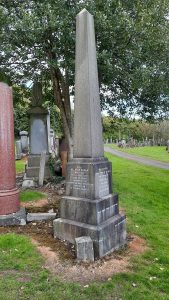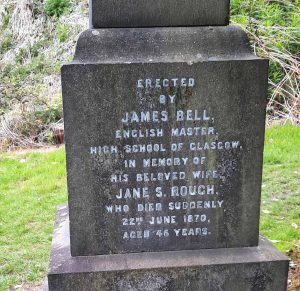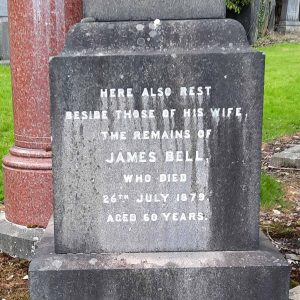James Bell (1818 – 1879) and Jane Somerville Rough (c1825 – 1870)
By Keith Clark and Morag T Fyfe
This description of James Bell appears in the minutes of the Kirk Session of St. Peter’s Free Church, 9 September 1879, just two months after Mr Bell’s death. These few lines give significant insight into James’ life as a philanthropist, a Christian, a teacher, an office holder of the Free Church of Scotland, and a social activist in Glasgow.
“Mr Bell’s labours as a philanthropist were not by any means confined to Free St. Peter’s Church, but in every agency affecting the spiritual good of the city he took a warm interest and lent a willing hand. His consistent character and conduct in all places, and on all occasions, were such as to adorn his profession as a Christian and his position as a teacher of youth, and as an office-bearer of the Church.” [1]
James Bell was not born into wealth or privilege. His mother, Jean Thomson, was married to William Bell, a haberdasher living on Nicolson Street in Edinburgh. [2] On Sunday 25 October 1818, Jean gave birth to her first and only child, James. [3] For the first four years of his life, James lived with his parents in Edinburgh, but his father’s death in 1822 left Jean a widow with a son to bring up alone.
James and his mother moved around a bit, first onto Princes Street, then to Gardners Crescent, and finally to Moray Street. James entered the High School of Edinburgh in 1829 at the age of 11 and remained until 1833. That year, at age 15, he began his teaching career as a pupil teacher at Niddry Street School. This school was one of Dr. Andrew Bell’s (no relation) schools that used the monitorial system to teach children. The fact that Dr. Bell’s system aimed to make “good scholars, good men, good subjects and good Christians” of students enrolled in the schools undoubtedly had an influence on James’ life. In the 1850s the Ordnance Survey Name Book for Midlothian described the school as teaching “all branches of an English education at the rate of one shilling per [month] with Latin one shilling and [sixpence] per month”.
In 1836 James was appointed Assistant Master at Niddry Street School. Now clear in his Christian faith, he decided to train as a minister in the Church of Scotland. While at the University of Edinburgh, James was a student of Thomas Chalmers, Professor of Theology and a leading evangelical in the Church of Scotland. It is from Chalmers that his sense of evangelism and his allegiance to the Free Church of Scotland would probably have originated.
Gaining standing as a teacher, James was appointed master at the new Greenside School in 1839, also run according to Dr. Bell’s principles. This school was held in a room of the newly opened Greenside Parish Church where James took on the role of superintendent of Greenside Sunday School. This year James faced a decision. He needed employment so that he could look after his ailing mother, but he also wanted to continue with his religious studies. His decision to stop taking theology courses and devote himself to teaching must have been a difficult one for him. As James’ career is explored, it is obvious that his deep religious convictions were to be a guiding principle all of his life, and he subsequently lived his faith through his activities in the church and the Sabbath School movement as well as other endeavours.
His mother’s death in 1840 resulted in James moving from 11 Leopold Place in Edinburgh to 1 Pilrig Place to reside with his uncle John Thomson and his family. James continued teaching at Greenside School where the enrolment had increased to about 400 students in all subjects. In 1843, 25-year old James moved to Leith where he took up residence at 18 Leith Walk.
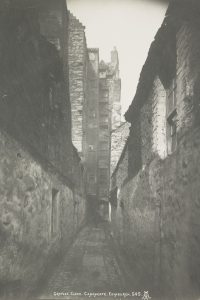
Gentles Close, Canongate, Edinburgh, by Alexander Adam Inglis
https://www.nationalgalleries.org/art-and-artists/118324/gentles-close-canongate-edinburgh
James was not the only former resident of Edinburgh’s Old Town living on Leith Walk at the time. When James was one year old and living on Nicholson Street, Archibald Rough, a successful upholsterer, and his wife Margaret Gardner married and established a home just over a kilometre away in Gentle’s Close just off Canongate. Their second child, Jane Somerville Rough, was born there about 1825. In 1832 the Rough family moved to Leith Walk, the long street connecting Edinburgh to the port of Leith, with their five children. It was in Leith that the remainder of their eight children were born, including their youngest daughters Elizabeth in 1836 and Helen in 1839. Jane, Elizabeth and Helen Rough were living on Leith Walk with their parents, siblings and maternal grandmother at the time of the 1841 census.
The Rough sisters would have met James Bell very soon after his move to Leith as their family was living in the same building, 18 Leith Walk. James was obviously attracted to the eldest sister Jane, now about 18 years old. The courtship between James and Jane lasted about two years until James moved to Glasgow in 1845. That year James opened Desmond Bank Academy in a villa on the corner of Sauchiehall and Scott Streets while living nearby at 59 Renfrew Street. This villa still exists, now incorporated into the premises of the Centre for Contemporary Arts on Sauchiehall Street. That same year he also joined St. Peter’s Free Church, Glasgow and was appointed an elder. When this congregation broke away at the Disruption of 1843 they stayed in the “old” church and paid rent until the new St. Peter’s Free Church was built at 53 Mains Street (now 58 Blythswood Street) near Waterloo Street in 1850.
The separation between James and Jane proved to be temporary and they married on 16 July 1846 in South Leith, Edinburghshire, Scotland before setting up home at 119 Murray Place (on New City Road), Glasgow.
In 1847 James continued to work as English Master at Desmond Bank Academy on Scott Street. Early life for the couple presented challenges. In 1845 his school started with an enrolment of three students and he was working hard to increase that number each term. Jane’s mother was struck down with “the fever” and died in Leith in September 1847. The following year James took on the additional duties of Session Clerk at St. Peter’s Free Church. Between attempting to keep the new Academy running, establishing himself as a teacher, his increasing commitments to his church, adjusting to marriage and supporting a wife, James and Jane would have had little leisure time together.
By 1849 life began to settle for James and Jane. After the death of her mother, Jane’s sister Elizabeth came to live with the Bells in Glasgow. The couple moved to 60 Buccleuch Street, Garnethill, and James accepted the position of English Master at the newly (1846) established Glasgow Academy, a school with strong connections to the Free Church. As was customary at that date for a school of this type it was an all boys’ school (girls were not admitted until 1991), something that the progressive James did not agree with. This became obvious in August of 1850 when James advertised in the Glasgow Herald [4] that he would offer private advanced classes for young ladies at the Academy from August 12.
Firmly established as a teacher at Glasgow Academy, James and Jane moved to 4 Kew Terrace in 1851, where the census of that year showed Elizabeth Rough, Jane’s sister living with them. Also present was Janet Thomson, a young cousin of James’. As Janet was still living with them at the time of the 1861 census it is possible that James and Jane brought her up. In 1856 James and Jane moved to 8 Kew Terrace. Already involved in school and church, James became a member of the Kew Terrace Board of Proprietors and served as the Chair of the Board for many years. [5]
At this time in Scotland it was recognised that the system of parish education was unable to cope with the strains placed on it by the large numbers of poor working class children and efforts grew to improve this situation. This movement, combined with an emerging awareness of social responsibility toward the disadvantaged of society, created the opportunity for many of the churchgoing middle class to become involved in social welfare initiatives. While their attitudes and efforts were at times paternalistic and moralising, they had a great influence on society. James, as an influential member of the Free Church became involved in that church’s evangelical outreach to the community in terms of social action to help people better themselves.
But it was not just James who was involved in such social activism. Jane supported him fully and joined him in his work. A contemporary writer describes her in this way
“She was singularly fitted to be his life companion. With the simplicity and heartiness that could enjoy their early struggles, she had the culture, the judgement, and the gentility that made her able to render a more conspicuous service when the struggles were over, and she was needed to take a leading part in all Christian activities of St. Peter’s Church, and in the varied philanthropic enterprises to which the Christian ladies of Glasgow have so strongly addressed themselves.”
“Unaffectedly devout, ardent in her affections, with a constant play of simple mirthfulness rippling the surface of a sober judgement, she was for him a helpmate indeed.”
James and Jane took in young gentlemen students as boarders at their home in Kew Terrace as the 1851 and 1861 censuses illustrate, and James publically promised that “he will supervise their studies with special attention paid to their moral and religious studies.” Although the Bells never had children, the boarders, Jane’s sister Elizabeth, and James’ cousin Janet would have filled that part of their lives.
James’ concerns about the future of education and educators in Scotland can be seen in 1854. As Scotland moved toward public state supported education, James took a leading role in scrutinizing what was being considered in the proposed Education Bill of 1854. Two months prior to the debate of the Bill in Parliament, James and seven other educators took out an advertisement in the North British Daily Mail asking for teachers to attend a meeting to
“consider the provisions of the Education Bill which bear directly on the interests of the Profession; and to take such steps as may seem best calculated to secure the modification or withdrawal of any Clause which the meeting may deem objectionable.”
In late spring of 1859 41-year old James considered a career move. The position as Master in the English Department at the High School of Glasgow became available. Undoubtedly he and Jane discussed what this would mean for them. He applied for the job along with twenty-one other candidates. The hiring committee reduced this to a short list of six names, one of which was James. At the Glasgow Town Council meeting of Thursday, 8 July 1859, a vote to appoint the new English Master was taken. The first vote ended with a tie between Mr Archibald Morrison BA, MA, Master of Glasgow Collegiate and James Bell. On the second vote James was elected by a one vote margin. Successful in his application, James left the Glasgow Academy becoming English Master at the High School of Glasgow, continuing in that role when the school was transferred to the Glasgow School Board in 1872. It was a position he held until his death.
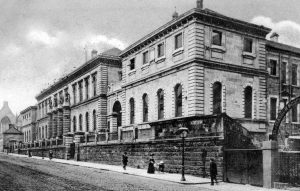
The central block of this building was the original Glasgow Academy designed by Charles Wilson in 1847. In 1878 it became the new home of the High School of Glasgow.
He was, by all contemporary accounts, a brilliant teacher who was greatly respected by his students. He took great care in his curriculum and introduced his students to the study of science, something that was unusual at the time. He encouraged his students to use logic and develop their reasoning powers. His Christian character influenced his teaching and he was known to be kindly, impartial, firm and respectful with his students. What was his influence on his students? People such as the industrialist William Beardmore, the architect Temple Moore, and British Prime Minister Andrew Bonar Law all attended the High School of Glasgow while James was English Master there. James would certainly have known Thomas Muir, a brilliant Scottish mathematician who was on staff with James from 1874. How well was James paid for his services? The only clue comes from a report by the Education Commissioner in the Glasgow Herald of 23 March 1868. His report of Glasgow High School states
“The present condition of this school is somewhat remarkable. It is not in fact a school, but six schools, each under a separate master, each almost entirely independent of the other. The patrons hardly ever interfere. Their theory is that they choose a good man, furnish him with a room in which he is to teach, appoint the subject which he is to profess, fix the price he is to charge for it, and then say to him “Now get as many pupils as you can, and deal with them as you like.”
The 1860’s were good years for James and Jane. James was an established teacher in a well respected school, Session Clerk in his church, a member of Kew Terrace Proprietors Association, and active in the Glasgow Sabbath School Union. He had also assumed a role in working with the Free Church in developing their Education Scheme which was to provide input to the government on how public education should be organized in Scotland. Jane supervised a houseful of bright, energetic and talented young boys and was active in her church.
The 1861 census showed that his cousin, Janet Thomson, was living with the couple at 8 Kew Terrace. Also in the house were eight young male boarders and three servants, one of which, a 24-year old Agnes Halliday would remain in James’ service until his death.
St. Peter’s Free Church appointed a new minister in 1864 and in 1865 James retired as Session Clerk of the church. Never one to rest, he became involved with the recently formed Foundry Boys Religious Society. This society was established in 1865 to help young boys who sought casual labour in the iron foundries but were considered to have too much free time on their hands for the rest of their day. The two aims of the society were to provide a diversion for the boys and to give them some spiritual guidance. This would have appealed to James as here was Christian evangelism merged with social activism aimed at youth. James became their Honorary President for 1865-1866 and then assumed the role of President, a position he held until his death. A measure of James’ character can be seen in this excerpt from a statement given by the Society upon his death:
“Members of the Council desire to express, however inadequately, their sense of the great value and importance of the services which Mr Bell rendered in the planning, in consolidating, and in extending the work of this Society. His thorough and practical piety, his sagacity, prudence, and sanctified common sense, gave to his advice and decision a force and weight which were recognized by everyone engaged in the work. To know him was indeed to love him and desire to imitate him.”
James led prayer meetings for the group and travelled to other towns to help them establish branches of the society so that more young boys, and girls as well, would be helped by this organization which is still in existence today.
James and Jane took some time to travel and in 1867 they, along with the Rev. Dr. Macmillan of St. Peter’s Free Church and the Rev. Richard Glover of Blackfriars Street Baptist Church (and later of Tyndale Baptist Church, Bristol) went to Denmark and Norway. During the trip Dr. Macmillan noted that despite being ill, James remained his ever patient and kind self. On part of the trip, Bell and his party ministered to a group of people afflicted with leprosy. In return, these suffering people expressed their sincere gratitude to them. Bell remarked how this was one of the most impressive things that had ever happened to him. A man of deep devotion, he helped preach at the daily services while on the trip and it was noted that both he and Jane led the singing. The trip had a lasting impact on James as he appeared to be affected by the beauty and the nature that surrounded him as they travelled the Scandinavian coast. For him this was a spiritual trip that re-enforced his strong faith.
Upon returning from their trip to Scandinavia, the couple resumed their lives in Glasgow at Kew Terrace. Both were involved in church work with the Free Church, James teaching and active in the now expanding Foundry Boys Religious Society. He prepared a lecture “Notes of a Tour in Norway and Denmark” and started offering it to interested groups.
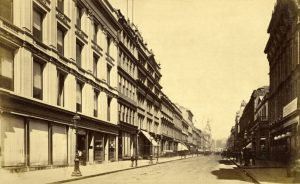
The bottom of Buchanan Street looking north c1880. Stewart and MacDonald’s warehouse is nearest the camera on the left followed by that of David Kemp & Son. https://www.glasgowhistory.com/buchanan-street.html
In 1869 Jane started to experience attacks of faintness. On Wednesday, 22 June 1870, she and James went shopping at David Kemp and Son’s warehouse on Buchanan Street in Glasgow. This was one of the high class emporiums found on Buchanan Street and specialised in all forms of ladies’ wear including shawls and furs. At 4pm that day, 45-year old Jane felt ill, collapsed and died suddenly of apparent heart disease with James by her side. James, shocked and distressed at the loss of his wife, felt unable to register Jane’s death until six days after her death and three days after her funeral in the Necropolis. Following the death of Jane, James’ sister-in-law, Helen Rough, came to live with him at Kew Terrance to keep house for him. The 1871 census showed James, Helen, a visitor and two servants (one was Agnes Halliday) living at Kew Terrace.
After the death of Jane, James continued his employment as English Master at the Glasgow High School as well as working with the Foundry Boys and the Sabbath School movement. In 1871 he gave a model lesson to the Greenock Sabbath School Union, and it was noted that this would be a “rare treat” because of Mr Bell’s experience in Sabbath School work. Through his work with these two groups, James was now intimately involved with Glasgow youth and their religious training.
At this time in Glasgow there was a great amount of co-operation among the various youth organisations in holding combined activities and in the exchange of speakers. The Sunday School Union, the Foundry Boys, the Bands of Hope and the Glasgow United Evangelistic Association had joint services, dinners and day trips. The relationship between the Glasgow Sabbath School Union, the Foundry Boys and the Young Men’s Society for Religious Improvement was so close that an amalgamation was proposed in 1871. Probably James played a role in all this, but it is not documented.
James continued as an elder in St. Peter’s Free Church even though the membership was declining as new churches were built in growing areas of the city. He also became a supporter of the West of Scotland Convalescent Sea-Side Homes, Dunoon.
In 1878 James became unwell and it was becoming obvious that his health was starting to fail. His sister-in-law, Helen, was still in residence at Kew Terrace and tended him in his final days. On Thursday 24 July James returned from a holiday in Pitlochry which had failed to be of any benefit to him and on the night of Friday 25 July 1879 he felt ill. Helen offered to sit up the night with him, he declined, but she persisted and sat with him. The next day, 26 July, he died of a heart attack at age 60 and was buried beside his wife on 31 July. His funeral sermon, in Free St. Peter’s Church on 12 October 1879, was preached by his friend the Rev. Richard Glover with whom he and Jane had travelled 12 years previously. Mr Glover chose scripture from 2 Timothy IV, v. 7 and 8 to form the basis of his summary of James’ life in the service of his church.
“I have fought a good fight, I have finished my course, I have kept the faith: Henceforth there is laid up for me a crown of righteousness, which the Lord, the righteous judge, shall give me at that day: and not to me only, but unto all them also that love his appearing.”
James left an estate of £3500 (about £430,000 in 2021). After leaving a small sum to his servant Agnes Halliday and an annuity to his cousin Janet Thomson, James divided the bulk of his estate between two of his sisters-in-law, Helen Rough and Elizabeth Rough/McClure. The funds were left in trust, the terms of which James clearly defined. He did not leave any of his estate to the church or any of the organizations that he worked with, his leadership in those organizations was his legacy.
For ease of reading and in order to minimize the use of end notes in this profile, a category or group of sources will be referenced only once, the first time it is used. Each individual source is annotated so that the reader may associate the reference with facts included in the profile.
[1] Direct quotations used in this profile have been taken from In Memoriam, James Bell. This small book contains a biography of James Bell, the sermon given at his funeral service as well as miscellaneous letters of condolence written at the time of his death. Not only is this book a source of quotes, but also a source for many of the insights into James’ personal life and his relationship with his wife Jane. The full text is available on line at: In memoriam of the late James Bell, English master in the High school, Glasgow URL: https://archive.org/details/inmemoriamlatej00bellgoog
[2] All addresses used in the profile have been sourced from the street directories of Glasgow, Edinburgh and Leith. They are available on line in a searchable form at: URL: Scottish Post Office directories – National Library of Scotland (nls.uk). This source also provided information about the employment of James at the time of the listing.
[3] The following records, available from the National Records of Scotland were used throughout this profile:
Censuses of Scotland:
- 1841, 1851, 1861, 1871.
Church and Statutory Registers:
- 02/01/1818 Old Parish Registers Marriages 685/2 200 37 St Cuthbert’s page 37: Bell-Thomson
- 15/06/1819 Old Parish Registers Marriages 685/3 190 249 Canongate page 249: Rough-Gardner
- 12/09/1847 Old Parish Registers Deaths 685/2 590 14 St Cuthbert’s Margaret Gardener/Rough
- 16/07/1846 Old Parish Registers Marriages 692/2 240 432 Leith South page 432: Bell-Rough
- 1870 Statutory Registers Deaths 644/6 328: Jane Somerville Rough
- 1879 Statutory Registers Deaths 646/2 422: James Bell
Wills and Testaments:
- 1879 Wills and testaments SC36/51/77 Glasgow Sheriff Court Wills: James Bell
All of the above records can be accessed at URL: ScotlandsPeople | Connecting Generations
Ordinance Survey Name Books:
- Midlothian OS Name Books, 1852-1853, Midlothian, Volume 106 page 12 URL: OS1/11/106/12 | ScotlandsPlaces
[4] Newspapers have been a valuable source of information about James’ life and his role in the Glasgow community.
The Glasgow Herald has been used as reference several times in this profile. Copies of this newspaper are archived at URLs: Google News Archive Search , http://www.britishnewspaperarchive.co.uk/ and in the newspaper collection on Find my Past. Specifically this profile refers to articles published on the following days:
- 2 August 1850: announcement that Mr Burt will assume Mr Bell’s classes at Desmond Street Academy.
- 9 Aug 1850: announcement by James Bell that he will conduct advanced classes for young ladies at Glasgow Academy.
- 28 July 1851: James Bell announces that he will be accepting boarders at his house and will attend to their “moral and religious” improvement.
- 20 July 1855: announcement of the start of the new academic year at the Glasgow Academy with staff list.
- 3 August 1855: James Bell notes that he has vacancies for three boarders at his home.
- 7 September 1857: advertisement by Bell re: a lady teacher.
- 8 July 1859: detailed account of the Glasgow Town Council meeting at which James was appointed English Master at the Glasgow High School.
- 11 August 1862: advertisement re: application of young ladies to be considered for boarders.
- 17 April 1863: Public Notice Re: Free Church Education Scheme meeting, James Bell in the Chair.
- 23 March 1868: Report by the Education Commissioner on Glasgow High School, page 6.
- 8 Jan 1870: announcement that Mr James Bell will speak at the January 30 meeting of the Patrick Popular Lectures on the subject “Norway”.
- 22 Jan 1870: brief article on James Bells’ talk on Norway given at the Patrick Popular Lectures.
- 18 March 1870: brief article on James Bells’ talk on Norway given at the Kelvinside Literary Association.
- 23 June 1870: announcement of the death of Jane Rough.
- 12 Jan 1872: brief article on James Bells’ talk on Norway given at the Glasgow High School Literary Society.
- 19 Feb 1872: report of the formation of the Hamilton Branch of the Glasgow Foundry Boys Society noting the role of James Bell.
Additional newspaper resources used in this profile:
- Glasgow Gazette – 05 May 1849: article on examination of students at Desmond Park Academy. It includes a description of the remarks made at the school on the departure of Mr Bell from that institution.
- The Reformers’ Gazette – July 1850: advertisement for Glasgow Academy, Mr James Bell, Master, English Department.
- North British Daily Mail – 15 March 1854: notice of meeting for teachers to discuss the Education Bill of 1854.
- North British Daily Mail – 4 February 1863: report of a meeting of the introduction of a minister to Broomielaw Mission Church . James Bell was a speaker.
- North British Daily Mail – 9 February 1869: a report on the annual general meeting of the Glasgow Boys Foundry Society.
- Greenock Telegraph and Clyde Shipping Gazette – 22 February 1871: notice of meetings for the Greenock Sabbath School Union under the direction of James Bell.
[5] Additional miscellaneous resources used in this profile: These varied resources have provided both general background and historical information as well as specific information about events in Scotland during the lifetimes of James Bell and his wife Jane Rough
- Kew Terrace, Minutes of the Annual General Meetings of the Kew Terrace Association (formerly the Kew Terrace Board of Proprietors) from 1856 to 2016. Contain minutes of meetings James Bell chaired along with his signature and comments of condolence upon his passing. URL: Archives – Kew Terrace, Glasgow
- The Sunday School Movement in Scotland 1780-1914 – Callum G. Brown URL: The Sunday-school movement in Scotland 1780-1914 : Brown, Callum G. : Free Download, Borrow, and Streaming : Internet Archive
- Glasgow City Archives, Records of Free, United Presbyterian, United Free and Other Protestant Churches 1725 – 1891 Reference CH3/1266, Glasgow, St Peter’s Free Church 1844-1855
- The Free Church of Scotland Monthly Record, Issue 12 ; 1 January 1864 page 422. A discussion of the Education Scheme proposed by the Free Church of Scotland. URL: The Free Church of Scotland Monthly Record – Google Books
- The Hidden Glasgow Forums: a discussion thread on Desmond Bank Academy, Glasgow URL: The Hidden Glasgow Forums • View topic – Desmond Bank Academy, Glasgow .
- Education and the State in Nineteenth-Century Scotland, R.D.Anderson, The Economic History Review, November 1983, Vol. 36, No. 4 pages 518 – 534: a discussion on the balance between private and public education in the nineteenth century. URL: Education and the State in Nineteenth-Century Scotland on JSTOR .
- Minutes Edinburgh School Board: 1877-1879, Jan 1891: information on Niddry and Greenside Schools.
- Oliver & Boyd’s new Edinburgh almanac and national repository 1840 and 1841 volumes: contain a listing of the staff at Dr. Bell’s Schools. Available at URL: Oliver & Boyd’s New Edinburgh Almanac and National Repository … – Google Books
- Distinctive and Inclusive The National Society and Church of England Schools 1811–2011 Lois Louden URL: Layout 1 (churchofengland.org)










